
Peer-to-Peer Summary
Cat: ICT
Pub: 2001
#: 0107a
Andy Oram
01331u/17z25r
Title
Peer-to-Peer Summary
ピア・ツー・ピア サマリー
Compiler
Andy Oram
Andy Oram
Published
2001
2001
Index
Why?
- Following is a report of the latest P2P situation summarized in
summer 2001, and made presentation at Glocom, IUJ.
- References:
- "Peer-to-Peer" Edited by Andy Oram, O'Relly, 2001
- "Sneaky Network Exponential", by David Reed,
- Jnutella Developers Workshop, NTT Mirai Laboratory
- "The Grid" Edited by Ian foster & Carl Kesselman,
1999
- 2001年8月に、以下参考文献を基に、P2Pの現状をまとめて、国際大学Glocomでも発表した。
- 参考文献:
- "Peer-to-Peer" Edited by Andy Oram, O'Relly, 2001
- "Sneaky Network Exponential", by David Reed,
- Jnutella Developers Workshop, NTTみらい研究所
- "The Grid" Edited by Ian foster & Carl Kesselman,
1999
Summary
要約
>Top
0. Prologue:
- The idea of peer-to-Peer ("P2P") is emerging to mark
a new step toward future evolution of the Internet. The first step
was the advent of "email", the second was "WWW",
then the third is "P2P." It is epoch-making that
P2P is not only a new type of useful application, but also adds
value of the network, shaping future direction of the networked
society. This could be expressed in Apollo-11 way: "P2P
is one small step for a user, one giant leap for the Internet."
0. プロローグ:
-
Peer-to-Peer (以下P2P) Applicationは、インターネットの進化の新たなステップである。第1ステップが電子メール、第2ステップがWWWとすると、第3のステップがP2Pである。
P2Pは、新しいタイプのアプリケーションであるばかりでなく、ネットワークの価値を引き出し、将来のネットワーク社会の進化の方向を示している点で画期的である。アポロ11号的に言えば、P2Pはユーザ個人にとっては小さな一歩だが、インターネットにとっては偉大な一歩である。
>Top
1. Advent
of P2P:
- P2P has erupted since summer in 2000:
Development and debate about P2P application broke out in US since
last summer in 2000. This phenomenon occurred having relations to;
- explosion of bandwidth like broadband trend of the Internet,
- trend of digitalization of contents causing fusion of telecommunication
and broadcasting,
- shift of initiatives of information flow to the consumer expressed
like "Control Revolution",
- increase of alternatives and voices of customer in economics
such as "Permission Marketing", "Customer Relationship
Management", "One-to-One Marketing", and
- increase of social functions of NPO and NGO.
- P2P originally means "Peer-to-Peer" (=equal standing
each other), but we can add figurative meaning of "People-to-People",
or "Power-to-People." Furthermore very rapid improvement
of the technology suggests meaning of "Progress-to-Progress."
- >Top P2P in itself:
Internet was fundamentally designed as Peer-to-Peer system such
as File Transfer Protocol (FTP), Telnet, Usenet, Domain Name System
(DNS), Unix-to-Unix Copy Protocol (UUCP), etc.
Thereafter as increase of the users of Internet, from later half
of 1980s, security issue became more important, necessitating Firewall,
Dynamic IP, Network Address Translation (NAT) to install Intranet,
as well as inducing additional guarantee, management, and layered
structure for commercial usage like Quality of Services (QoS)
Just then, controversial issues sprouted up who controls and sponsors
Internet; autonomous organization or finally nation-state, together
with the issues of sovereignty of telecommunication, taxation, export
of encryption, Decent Act of Telecom, etc. It looks like a war for
authority of Internet between a camp of Server-Clinet versus that
of Peer-to-Peer.
- >Top Change of Bandwidth:
Regarding to interactivity, limited channels in terrestrial broadcasting
expanded to use more satellite and cable TV channels, including
challenges to more telecom-like services such as Video On Demand,
or Stream works over Internet. In telecom sphere, telephony has
been the core service, which is voice-centric interactive one-to-one
communication, but also enforced to use as access connection via
modem to the Internet. Users have urged to connect always to the
Internet with flat-rate tariff. For more broadband connection, it
is getting popular ADSL (Asymmetric Digital Subscriber Line) and
Cable Modem using cable TV line, though both remain still middleband
range, switching ISDN anymore. However, it still contained a kind
of restriction; asymmetric bandwidth for the Internet with narrower
upload and broader download capacity, which seemed enough for Web
surfing.
- >Top P2P Again:
It has been a dream that quick deployment of Fiber-to-the-home (FTTH)
to realize full-scale Internet environment with always-connected,
broadband, symmetric band usage. Symmetry in bandwidth is particularly
important to realize self-publishing like authoring and publishing
information over the Internet. P2P aims to revive no difference
between the function of server and client.
1. P2Pの登場:
- P2Pは2000年夏から:
P2P Applicationについては、米国中心に2000年夏より注目されてきた。P2Pの概念は、
- それを可能にするInternetの帯域の爆発的な拡大、
- 通信・放送の融合化傾向、
- 情報の流れやコントロールを変えようする動き(Control革命) 、
- 経済分野でも顧客の選択肢と発言権の増大 (Permission marketing, CRM, One-to-Oneなど) 、
- さらにはNPOやNGOの社会的な役割の増大などと密接に関連している。
- P2Pは、"Peer-to-Peer"が原義であるが、"People-to-People"、あるいは"Power-to-People"の側面を持つ。また技術的には、いわば
"Progress-to-Progress"のように進化が加速している面も見逃せない。
- もともとP2P:
インターネットは、当初のネットワーク・アーキテクチャが本来的には、Peer-to-Peerであった。 (FTP, Telnet,
Usenet, DNS, UUCPなど)
その後、ネットワークの利用拡大に伴い、1980年代後半からセキュリティが注目され、FirewallやDynamic IP、NAT(Network
Address Translation) が普及し (Intranet)、同時にQoSなど利用目的に応じた保証と管理と階層構造が導入された。
折しも、インターネットの管理やスポンサーを巡って、自律的な組織か、最終的には国家かが、通信主権、課税、暗号輸出、盗聴、通信品位法などを巡って論争となった。これは、さながら権力を巡るServer-Client陣営対Peer-to-Peer陣営の争いに見える。
- 帯域の変化:
双方向性に関しては、地上はの数少ないチャネルの選択からより多くのチャネルの時代 (衛星放送、CATV) へ移行し、任意の時間のリクエストによるサービス (VOD、インターネットでのStream
works等) など通信的な要素を取り入れてきた。通信の世界では、音声専用の1:1双方向通信の電話が中心であったが、これをインターネット接続するにはモデム接続を余儀なくされてきた。ユーザはインターネットへの常時接続を固定料金で強く望んでいた。また広帯域化の動きとしては、ADSLやCable
Modem (まだ中帯域だが) への利用が広がり、ISDN接続は不人気となった。しかしまだ制限がある。下りに比べて上りが狭いという非対称の接続方法である。これは、Webを検索する目的としては十分と考えられてきた。
- 再び、本来のP2Pへ:
長年の夢は、FTTHの実現によって、ようやくインターネット本来の常時接続・広帯域・対称的帯域利用の早急な実現である。帯域の対称性は、情報を編集して発信するためには特に重要である、P2Pでは、再度、Server機能とClient機能の区別がなくなる。
- >Top More competition and dilemma:
Broadband environment for P2P can accelerate 'Everything on IP'
including Voice over IP (VoIP); which will give serious impact on
existing common carriers into changing their service menu, as they
have maintained hierarchical guarantee-based switched network for
long years. What would happen if PSTN was replaced by VoIP regarding
to their universal service, or Digital Divide issue? And what would
be the robust analog telephone service with power feeder which is
independent on home electricity?
There is another dilemma in mobile telephone; the bandwidth is obviously
too limited for mobile telephone to allow always-connected and broadband
usage. Mobile Internet system forms a bottleneck at the gateway
servers due to its network topology. The Internet and the mobile
Internet are alike in appearance but different in nature. Mobile
Internet is easy to charge fee, but difficult to defend SPAM or
annoying mails. (It is controversial in Japan that iMode service
charges for even receiving email.)
Broader band service by next generation of mobile (IMT2000) may
cause another dilemma; weather to reduce tariff rate including voice
which enforce to deteriorate company profit, or to maintain relatively
expensive tariff which may adversely effect new services. Furthermore
wireless LAN (802.11 series) service will sure to compete with such
mobile Internet particularly in central urban areas.
- Definition of Broadband:
Broadband network has broader meaning of definitions. It should
be bandwidth of 4-5Mbps which can receive movie data without irritation.
To realize this, 10Mbps Ethernet, or more properly 100Mbps Ethernet
for exclusive use will be necessary. Therefore, connection via ADSL
or Cable Modem should be only middleband range, though they are
speedier than the present 64Kbps or 128Kbps ISDN. To realize real
broadband services, FTTH environment will be indispensable together
with in-house cabling by optical fiber, Ethernet, or wireless LAN.
- CompetitionとDilemmaの激化:
P2Pが実現するような広帯域環境では、"Everything on IP"、特にVoIPが促進される。これは、階層的な帯域保証の交換網を維持してきたコモンキャリアにとって、主たるサービスの変更を意味する。電話がVoIPに取って代わる時、ユニバーサルサービスやデジタルデバイドの問題はどうなるのか。現在の電話の持つ給電など、家庭での電気事情に依存しない現在のアナログ電話の堅牢さは、どう代替されていくのだろうか。
さらにまた携帯電話の市場でもジレンマを抱えている。携帯電話では帯域上、常時接続や広帯域化には限界がある。モバイル・インターネットにおいても、ネットワークの構造上、Gateway構築にボトルネックが生じており、インターネットの世界と似て非なる状況とならざるを得ない。これは課金が容易である反面、迷惑メールやSPAM攻撃に対し有効な対策が非常に困難である。 (日本では、iModeでメールを受信するだけで課金されることが大問題になっている。) また次世代携帯による広帯域化(IMT2000) に伴い、課金政策上のジレンマ、即ち、音声サービスを含む利用料金の低下による経営の悪化、さもなくば、利用料金が高額となり普及が妨げられる。また都市中央部では、無線LAN
(802.11シリーズ)との競合も間違いなく生じる
- Broadbandの定義:
ブロードバンドネットワークは、いろいろな定義があるが、動画をストレスなく受信できる帯域幅、即ち実効4-5Mbps程度以上とする。実際には、10Mbpsのイーサーネット、理想的には100Mbpsのイーサーネット程度が専用できる環境をいう。従って、ADSLやCable
Modemは、現状のISDNの64Kbpsや128Kbpsに比べれば、ミドルバンドに過ぎず、ブロードバンドとは言えない。ブロードバンドは、FTTHが実現し、各宅内がOptical
Fiber、Ethernet、無線LAN等で配線されている状況を想定している。
>Top 2. Definition of P2P:
- Red dot is
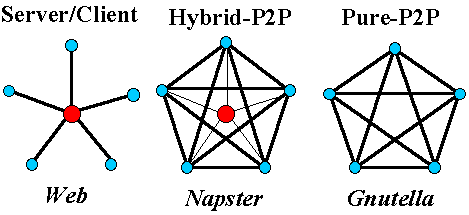 server, while blue dot is client.
server, while blue dot is client.
- The left is Server-Client type. (E.g. Web)
- The center is Hybrid or Semi-centralized application, where the
server has only directory of information. The clients, getting directory
information from the server, begins to download the information
between the relevant clients. (E.g. Usenet, NNTP, Instant message,
Napster)
- The right has no server function. The client also holds server
function (called "servent"). Retrieval and downloading
of files occurs between the clients. (E.g. Gnutella) Message for
searching is broadcast, while it is communication in downloading
between the clients along the responded route.
- Practical solution of P2P network:
P2P is emphasized of having no centralized server, but it is more
essential to be able to communicate concurrently searching the target
without prior knowledge. (Dynamic and smart query)
"Hybrid-P2P is also called as "semi-centralization",
or "soft centralization". It is one of the practical solution
in such intermediate network architecture, which would be a necessary
passage of evolution from Server/Client to P2P architecture. After
the appearance of Napster as Hybrid-P2P, Gnutella was developed
as a pure-P2P system, which tries to require additional functions
like user authentication with the help of "Hypbrid-P2P"
architecture. (Phenomenon of "P2P curve", or "P2P
boomerang")
2. P2Pの定義:
- 赤丸はサーバ、青丸はクライアントである。
(出典:NTT未来ねっと研究所)
- 左端はServer/Client型 (例:Web)
- 中央は、サーバにクライアントの情報のDirectoryのみを持ち、ダウンロードはクライアント間で行うHybridあるいはSemi-centralized
application (例:Usenet (NNTP), Instant message, Napster)
- 右端は、サーバの機能がない。 (クライアントはサーバの機能を兼ねる(Servent)。ファイルの検索・ダウンロードもクライント間で直接行う。 (例:Gnutella)
また、情報検索は一斉同報の放送型で行うが、ダウンロードは、ルートをたどって戻る通信型で行う。
- P2Pネットワークの現実解:
P2Pは、中央のサーバがないことが強調されているが、実際には、固定的なサービスの存在を予め知らなくても、実行時にダイナミックに通信相手を予備知識なして目標を検索できる点がもっと重要な点である。 (ダイナミックでスマートな検索)
また、"Hybrid-P2P"は、別名"semi-centralization"、あるいは"soft
centralization"とも呼ばれ、この中間的なネットワークの中に、Server/ClientからP2Pに向かうネットワーク進化上、通過しなければならない現実解を見ることができる。
Hybrid-P2PであるNapsterの後で、Pure-P2PであるGnutellaが開発されたが、今後は、再びユーザ認証などをHybrid-P2Pのサーバで行うような動きがでてきている。 ("P2P
curve"あるいは"P2P boomerang現象")
>Top 3. Evolution of P2P:
- The left chart indicates the three directions of evolution
of P2P
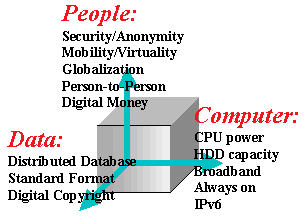 application; the three axes are; 1) People 2) Data , and 3) Computer. The P2P application is developed placing
emphasis on each factor.
application; the three axes are; 1) People 2) Data , and 3) Computer. The P2P application is developed placing
emphasis on each factor.
- 1) People-axis;
People means chase of possibility of encounter with unknown human
beings as a target of sending and receiving of information, assurance
of easy communication medium with already-known people, and frequent
exchange with business customer and partners. Instant Messaging
like ICQ is one of typical P2P application, enabling instant contact
with various combination of groups of people on the network.
Animals, including human species, are essentially mobile,
having special concern and adherence to its "locality",
as well as having interest in global relationship (=could be expressed
as "Glocal"). Consequently, people have
ceaseless desires to have exchange of information and resources
in both real and virtual environment. This is a challenge to heterogeneity
and novelty, notwithstanding wedded to homogeneity and maintenance
of the status-quo. Such ambivalence will produce basic energy to
develop P2P applications.
The essence of eBusiness is pursuit of effective matching between sellers and buyers in the market, because humans represents
almost all economic value and are major consumers. Business sphere
has carefully watched the trend of interest of people through communication
like chat, special interest group (SIG), and mailing list (ML) as
well as current email and Web. Auction site on the Internet is a
kind of P2P-oriented business.
Also such media have supported peoples' activities of virtual corporation
or virtual organization transcending physical time and distance.
Today's activities of NPO and NGO could not have flourished without
use of the Internet.
- 2) Data-axis:
This axis means usefulness of access to distributed database;
such as broadcast research query, and file transfer, storage of
backup files, collaboration of making digital product using distributed
sources and skills. Information is effectively stored and condensed
in the forms of database, archives, libraries, published information
or digital commodities, usually in the distributed environment.
And even locations of the necessary information are separated from
where humans live, the network can realize integrate them by retrieval
on the network.
The Internet has developed various convenient searching tools like
Fetch, Gopher, Anarchie, then browsers as current killer application.
Now new P2P file sharing idea has appeared like Napster,
Gnutella, Freenet, etc.
XML technology is focussed as standardization of database utilization
technology.
Furthermore, the issue of digital copyright is getting critical
how to balance the creators' incentives and effective utilization
of contents. The idea of "Copyleft" should be more studied
to maximize contents flow in coming P2P environment.
- 3) Computer-axis:
This axis means power of collaboration of redundant capacities of distributed computers and devices; because the Internet succeeded
to connect enormous number of computers with redundant capacity.
These virtual collaboration of distributed CPU powers can function
like a virtual super computer. There are several research
programs have already performed in the scientific research fields
which need huge capacity of computation; SETI@home and other medical
research are typical such examples.
Capacity of CPU and memory storage of computers are rapidly growing.
And PDA, Mobile telephone, and various appliances are diversified
coexisting with computers. Expansion of bandwidth may bring more
drastic changes than the growth of CPU capacity; always-connected
wired environment will be common, and the shift to next generation
IPv6 from the present IPv4 will be soon unavoidable.
3. P2Pの進化:
- 左図は、P2Pアプリケーションの進化を3つの方向でイメージした。3つの軸とは、人間 (People) と情報 (Data) とコンピュータ力 (Computer) である。これらの要素の組み合わせにに基づいて、P2Pアプリケーションが開発されている。
- 即ち、1) Peopleの軸とは、情報の受発信相手としての未知の人間との出会い、既知の人間との容易な通信手段の確保、ビジネスの顧客・パートナーとの頻繁な交流を意味する。
ICQなどインスタントメーセージングは、P2Pアプリケーションのひとつの典型であり、ネットワーク上のさまざまな組合せでのグループの人間との簡便なコンタクトを目的としている。
特に、人間を含む動物はは本質的にMobileな存在であり、それぞれのLocalityへの関心やこだわりを持つと同時に、Globalな関係をも維持し、 (即ち、"Glocal"な存在であり) 、その結果として人々は、RealにせよVirtualせよ情報・資源交流を可能にしたいという欲求を常に持ち続ける。これは、人々が同質性や現状維持にこだわると同時に、異質性や新奇性への挑戦願望をもっていることによる。このようなAmbivalentな存在こそが、P2Pの進化の根源エネルギーとなっている。
E-Businessの本質は、市場での売買の効果的マッチングの追求である。それは人間がほとんどの経済的価値をもち、主要な消費者であるからである。ビジネス業界は人々の興味の方向について、さまざまなグループコニュニケーション、例えば現在のemailやWebと並んでチャット、SIG、MLを通じて注目してきた。インターネット上のオークションサイトは、P2Pに着目したビジネス形態と見なせる。
さらに、これらのメディアは、時間空間を超えてVirtual Corporation、Virtual Organizationの人々の活動を支えてきた。
今日のNPO, NGOの隆盛もインターネットの活用なくしてはあり得ない。
- 2) Dataの軸とは、分散データベースへアクセスすることの効用である。例えば、一斉同報検索、ファイル転送、バックアップファイル保管、分散している素材や技能によるデジタル製品の協同作業など。
情報は、種々のデータベース、アーカイブ、図書館、公開情報、あるいはデジタル情報や商品の形で、通常は分散環境に効率的ない保管・凝縮されている。たとえ必要な情報が人間が仕事する場所と離れていても、ネットワークで迅速に遠方で分散している情報を検索することでそれらを統合できる。
インターネットは、種々の便利な検索ツールを発達させてきた。例えば、Fetch、Gopher, Anarchieから現在のキラーアプリであるBrowser。そして今や新たにP2Pファイル共有の考えが登場し、ファイル共有システムが登場した。XML技術は、データベース活用技術の標準化として注目されてきている。
さらに、創作意欲の維持とコンテンツの有効活用の観点からDigital Copyrightの課題は急務である。また"Copyleft"の考えも、P2P環境でのコンテンツ利用の拡大を図る上でさらに研究すべきである。
- 3) Computerの軸とは、分散しているコンピュータやデバイスの余剰処理能力で協業する力を意味する。なぜならば、インターネットは巨大な数の余剰能力のあるコンピュータを接続することに成功してきた。これらの分散しているCPU力を合わせる仮想的なスーパーコンピュータのようない機能する。すでに巨大な計算能力を必要とする科学研究の分野ですでに実施されている。
SETI@homeや癌など医療研究分野はその典型的な事例である。
これからも、ComputerのCPU能力は飛躍的に向上し、メモリー容量も拡大していく。一方、PDAやMobile telephoneやApplianceへと多様化な進化をしてコンピュータと共存していく。帯域の拡大 (Broadband化) は、CPU能力以上に劇的な変化が起こる。有線環境では常時接続が一般的となり、現在のIPv4から次世代のIPv6への移行は早晩避けがたい。
>Top 4. Meme Map of P2P:
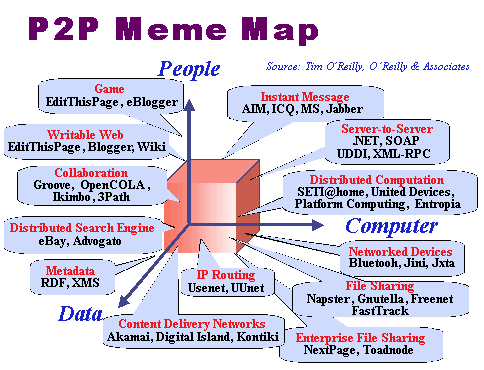
The left chart shows P2P Meme Map, where "meme"
means a kind of gene of thought. Three axes are the directions of
evolution: "People", "Data", and
"Computer".
- File Sharing: (Napster,
Gnutella, Freenet)
Napster is not a pure P2P system because it depends on directory
service of a central server, while Gnutella and Freenet are decentralized
systems.
The real innovation of Napster is to make any consumer also becomes
a producer of files for the network. Once you download a file, your
PC is available to pass along the file to other users. Such automatic
"pass along" participation decentralizes file storage
and network bandwidth.
- IP Routing: (Usenet, UUCPnet,
UUnet):
Usenet was originally carried over the informal, P2P dial-up network
known as UUCPnet. Sites agreed to phone each other, and passed mail
and news from site to site in a store-and-forward network. Over
time, some sites were better connected than others; they became
de facto "Usenet backbone", later called "UUnet"
adding TCP/IP services as the first commercial Internet Service
Provider (ISP).
- Metadata: (RDF)
The core of the Word Wide Web Consortium's (W3C) metadata vision
is a concept known as the Semantic Web. This is not a separate
Web from the one we currently weave and wander, but a layer of metadata
providing richer relationships between the the disparate resources
we visit. Resource Description Framework (RDF) is XML serialization
syntax for describing resources, turning those flat hyperlinks into
arcs, allowing us to label not only the endpoints, but ascribe meaning
to the relationship between the two resources at hand.
4. P2Pの遺伝子マップ:
- P2Pアプリケーションの発展型を展望すると、People、Data、Computerの3つの方向に沿ったP2Pアプリケーションが登場している。
(上図参照、なお"Meme"とは思想的因子)
- File Sharing: (Napster,
Gnutella, Freenet等):
Napsterは、中央サーバのdirectoryサーバに依存するので、純粋なP2Pシステムではない。GnutellaやFreenetは中央サーバがないシステムである。
Napsterの真の革新性はどの消費者もネットワークのためのファィルの生産者にすることにある。一度ファイルをダウンロードすると、そのPCは、他のユーザにファイルを回覧する。このような自動回覧の参加はファイル保存や帯域を分散することになる。
中央のサーバがfile directory機能などで情報交換の仲介を行うで、厳密にはP2P systemとは言えない。GnutellaやFreenetは、このような中央サーバの機能がない。Naspterの革新性は、Napsterのconsumerが自動的にproducerの機能を有することである。
- IP Routing: (Usenet, UUCPnet,
UUnet):
Usenetは、元々P2P的な非公式なダイヤルアップ接続するUnix-to-Unixe Copy Protocol Net (UUCPnet)として始まった。サイト同士が互いに電話をかけて、メールやニュースを蓄積交換方式で相互転送した。他よりよく接続されるネットワークは自ずから"Usenet
backbone"となり、後に"UUnet"として、TCP/IPサーバを加えて、最初のcommercialなISPになった。
- Metadata: (RDF) :
W3Cでのmetadata分科会での中心課題は、意味のあるWeb (Semantic Web) として知られる概念である。これは現在、我々が検索したり迷ったりしている孤立したWebではなくて、我々が訪問するばらばらのリソースの間にもって豊富な関係を記述するメタデータ層を有するということである。Resource
Description Framework (RDF)はリソースを記述するXMLでのシンタックスであって、今までの平坦なハイパーリンクをいわば弧状にして、両端の情報だけでなく、2つのリソース間の関係情報を記述する。
- >Top
- Distributed computation: (SETI@home)
Served from the Space Sciences Lab at U.C. Berkeley, SETI@home runs
as a screensaver that uses distributed redundant capacity of more
than 1 million PCs to process radio telescope data in search of
signs of extraterrestrial intelligence. This is asymmetric client/server
architecture, where clients download their data sets and upload
their computed results to the central server. But the clients are
active participants, not just passive "browsers." Hundred
of millions of interconnected PCs that have hitherto been largely
passive participants; they are called "the dark matter of the
Internet."
Both distributed file sharing and distributed computation are aspects
of a new world ,where the whole is much greater than the sum of
its parts.
Millions of PCs and P2P technology are equivalent to ten times of
capacity of the latest super computer; 50 Tera-FLOPS. There are
other similar application in medical research fields such as development
of medicine for leukemia.
- Instant message: (AIM, ICQ,
Groove, Jabber)
Instant messaging is similar to Napster model; in each case, a central
server manages an addressing and identification of users. Napster
can be thought of as an instant messaging system only with such
difference; "Are you online and do you want to chat?"
but, "Are you online and do you have this song?"
Jabber and Groove provides an XML routing infrastructure that allows
for the formation of ad hoc peer groups. These can share not only
files and chat, but a wide variety of application such as replication,
security and so on.
Groove, developed by Ray Ozzie's Groove Networks, will be so-called
P2P version of Lotus Notes; allowing to furnish customer support,
eLearning, collaboration between different vendor's software over
the Internet, but requires brokerage function of the central server
to find a partner and to set up links between the nodes.
Microsoft plans to integrate this IM software function into their
latest Windows-XP, aiming to monopolize distribution of various
services and collection of customers' profile by this online directory
service.
- Distributed computation: (SETI@home)
U.C. BerkeleyのScience Labが提供するデータを、分散しているコンピュータの余剰処理能力(100万台以上のPC) を活用して、スクリーンセーバとしてSETI@homeを動かして、電波望遠鏡のデータを解析して地球外知的生命の兆候を調査している。これは非対称なクライアント・サーバであり、クライアントはデータを受信して計算結果を中央のサーバに送信する。しかし、クライアントは、単に受け身に単にブラウズしているのではなく積極的な参加者なのだ。何億台というPCはいままではほとんどが受け身の参加者であった。これらのPCは「インターネットにおける暗黒物質」と呼ばれていた。分散ファイル共有と分散コンピュテーションは新たな世界を切り開くものである。それは、部分の集合よりも全体の方がずっと大きいことを示している。
数百万のPCとP2P技術は、現在最高速のスーパーコンピュータの約10倍、50 Tera-FLOPSの性能を実現している。 他の応用事例としては、白血病治療薬の開発など医療研究分野がある。
- Instant message: (AIM, ICQ,
Groove, Jabber)
Napster同様に、Instant messagingは、中央サーバがaddressing, ユーザのidentificationなどの機能を行う点では似ている。即ち、"Chatをしませんか"というのと"このFileを持っていませんか"というのとの相違に過ぎない。
JabberやGrooveの場合は、さらにXML routing infrastructureを使って、ad hoc peer
groupを作成し、chatやfile交換だけでないreplicationやsecurityなどの種々のapplicationを共有することができる。
Grooveは、いわばLotus NotesのP2P版であり (Lotus Notesの開発者であるRay Ozzie氏のGroove
Networksが開発) 、インターネットを介して、カスタマーサポート、オンライン学習、異なるベンダーのソフトウェア間での共同作業が可能なP2Pソフトウェア製品である。但し、Napster同様、相手を発見するためにノード間リンクをセットアップする仲介人は必要になる。
Microsoftは、次期OSであるWindows-XPにこのIMソフトを組み込み、Online Directoryの支配によって、サービスの配信や顧客データの収集を独占することを狙っている。
- >Top
- Writable Web: (EditThisPage,
Trellix, Blogger, Wiki):
The Web was originally designed by Tim Berners-Lee to share their
research data, but later it was recast into a publishing medium
which attracts million of passive consumers. To this day, there
is a strong P2P element in the Web architecture; hyperlink can point
to any other site on the network, without central intervention and
without the permission of the site being pointed to. Now Web browser
became a kind of universal client which can link to any Internet
resource. Initially Web were competing with FTP, Gopher, and WAIS,
but eventually, through CGI, the Web became an interface to any
information resource. Mailto and news links even provide gateways
to mail and Usenet. But there is still fundamental flaw in the Web;
there is gap like heaven and earth: i.e. smaller number of Web server
and many Web browsers.
There is an innovation of creating web sites that are writable by
anyone in an area set aside for public comment on a given topic.
- Writable Web: (EditThisPage,
Trellix, Blogger, Wiki):
Webは、当初は研究データを共有するためにTim Bernerd-Leeが設計したものだったが、後に、書き直され何百万の受動的なユーザを引きつける出版メディアとなった。今日に至るまで、Webの構造にはP2Pの要素が強く見られる。ハイパーリンクによってネットワーク上の他のサイトを、中央サーバの仲介や、対象とされたサイトの了解なしに指し示すことができるからである。今やWebブラウザは、どのインターネット上のリソースともつなぐ普遍的なクライアントソフトウェアとなった。当初Webは、FTP、Gopher、WAISと競合していたが、結局CGIを通じて、Webはどの情報リソースへのインターフェイスとなった。MailtoやNews
linksは、電子メールやUsenetのゲートウェイともなった。しかしながら、Webには根本的な欠陥がある。それは少数のWebサーバと多数のWebブラウザという、いわば天と地のようなギャップである。
そこでWritable Webが作られて、だれでも与えられた話題についての一般のコメントを自由に書き込める領域を用意したのである。
- >Top
- Server-to-Server: (.NET, SOAP,
UDDI, XML-RDC)
Perl has been widely used to build interfaces to Web sites that
do "screen scraping"; addressing to particular URL with
static information with the clue of static DNS database.
SOAP (Simple Object Access Protocol) makes this process more
explicit, turning Web sites into peers; enabling to trace dynamically
available nodes without prior knowledge about the fixed URL.
In order for Web clients and servers to use others as resources,
they need a standard way to discover each other, the way Java-enabled
devices discover each other through Jini; such initiative
is called UDDI (Universal, Description, Discovery, and Integration).
Microsoft.NET envisages to integrate their products and services
via ".NET platform" supposing all devices are to
be connected to the Internet. ("Office" software will
be an ASP application.) Also Microsoft published new language called
C# as the development tool.
- Server-to-Server: (.NET, SOAP,
UDDI, XML-RDC)
PerlはWebサイトが画面を書き替えるためのインターフェイスとして広く利用されてきた。それは、静的な情報をもつ特定のURLを静的なデータベースであるDNSを手掛かりに見つける仕組みである。
SOAP (Simple Object Access Protocol) は、このプロセスをもっと精緻にして、WebサイトをPeerにした。つまり固定的なURLを予め知らなくてもダイナミックに
利用可能なサイトに探すことができる。
Webクライアントとサーバがそれぞれ相手をリソースとして利用するためには、相互に発見するための標準的な方法が必要となる。Java搭載のデバイスが相互に発見するためにJiniを利用したようにである。このような方法がUDDI (Universal, Description, Discovery, and Integration)といわれる仕組みである。
なお、Microsoft.NETのビジョンは、すべての情報機器がインターネットに接続されることを前提にして、同社の製品・サービスを包含する".NETプラットフォーム"の構想をもっている。 (OfficeもASP化される) このためのソフトウェア環境として、C#という新たな言語を発表した。
- >Top
- Networked Devices: (BlueTooth,
Jini, Jxta)
Computing devices are some fixed, some mobile, some embedded in
a variety of appliances. We need technologies that allow the formation
of ad hoc peer groups between devices. BlueTooth and Jini are such technologies; when I walk into a room with my wireless
laptop, and it queries other devices; "Are there any printers
here?" Key technologies include resource discovery, reliability
through redundancy, synchronization, and replication.
Sun's slogan "The network is the computer" is now
coming true by P2P technologies. Succeeding idea came out by J-Spaces,
"The space is the computer."
- Networked Devices: (Bluetooth,
Jini, Jxta)
コンピュータのデバイスは 固定、移動、あるいは種々の情報機器に埋め込まれている。我々は、その都度適宜デバイス間でPeerグループを作れるような技術を必要としている。BlueTooth やJiniはこのような技術である。例えば無線のノートPCを持って部屋に入ると、PC自身が「ここにプリンタはないのか」と探すようになる。キーとなる技術としては、利用するリソースの発見、リダンダンシーによる信頼性向上、ファイルの同期や複製である。
Sunのスローガンである"The network is the computer."がまさにP2Pによって実現しようとしている。さらに、"The
space is the computer"の考えをJ-Spacesが唱えている。Bluetoothは、様々な環境にある (固定、移動、アプライアンス) に対し、ad hoc peer groupによってデバイス間の接続を実現する。例えば、ノートPCを移動して、その場所にあるプリンタを借用してプリントアウトするなどが可能になる。このキーとなる技術は、利用資源の検索
(resource discovery) 、redundancyによる信頼性向上 (reliability through redundancy)
、同期 (synchronization) および複製 (replication) である。 (Sunのsloganである"The
network is the computer."がまさにP2Pによって実現しようとしている。続いて、"The
space is the computer"の考えも出てきた。 (J-Spaces))
Remarks:
- 1) Jxta:
In Feb. 2001, Bill Joy of Sun Microsystems announced a new open-source
software "Jxta" (short of 'Juxtapose', as in side
by side), developing basic building blocks for P2P application,
following Java (1994) and Jini (1999).
Jxta has 3 layers; a core layer, a middle services layer, and an
application layer. The core layer includes protocols to enable
key mechanisms for P2P networking (discovery, transport including
firewall handling, and the creation of P2P groups. The service
layer provides hooks for generic services (searching, sharing
and added security. And finally, the application layer supports
implementation of integrated applications, such as file sharing,
resource sharing, monetary systems, distributed storage, etc.
(Glossary: 'Peers' (=any device), 'Peer groups'(=collection
of peers), 'Pipes'(=unidirectional communication between
peers, 'Codat' (=code, data, application, or other computer
representable resources.)
- 2) Jxta vs. .NET:
.NET borrows extensively from Java concepts. It consists of common
run-time execution environment and a set or developer tools with
Microsoft development languages and environment such as Visual Basic,
ASP, Visual C++, and now C#.
Jxta is not a programming language; it provides a set of protocols
that support interoperability in P2P environment. Jxta applications
can be developed in any language and underlying operation system.
- 1) Jxta:
2001年2月にSun MicrosystemsのBill Joyが, P2Pアプリケーションの標準"共通語"を狙うオープンソースのソフトウェア"Jxta"を発表した。
(並列するという意の'Juxtapose'から) これは、Java (1994年) , Jini (1999年)
に次ぐ発表である。
Jxtaは、3つの階層、即ちコア層、中間のサービス層、アプリケーション層から成る。コア層にはP2Pネットワーキングの基本プロトコル
(相手の発見、転送 (ファイアウォール対応を含む) 、P2Pグループ生成) が含まれる。サービス層は一般サービス (検索、共有、セキュリティ追加)
のために仕組みが提供される。最後のアプリケーション層は、ファイル共有、リソース共有、決済機能、分散保管などの統合アプリケーション作成を支援する。
(用語集: 'Peers' (=どのdeviceでも), 'Peer groups'(=Peersの集合),
'Pipes'(=Peers間の一方的な通信), 'Codat' (=コード、データ、アプリケーションなどコンピュータの扱うリソースの総称)
- 2) Jxta 対 .NET:
.NETは、Javaの思想を大いに借用している。それは共通のランタイムの実行環境とMicrosoftの開発言語であるVisual
Basic, ASP, Visual C++、さらには新たなC#などの開発ツール類から構成される。
Jxtaは、まずプログラミング言語ではない。それはP2P環境でのプロトコルや相互運用を支援を提供する。Jxtaアプリケーションはどの言語でのどのOS上ででも開発が可能である。
>Top 5. Toward Smart P2P Society:
- The impact of P2P
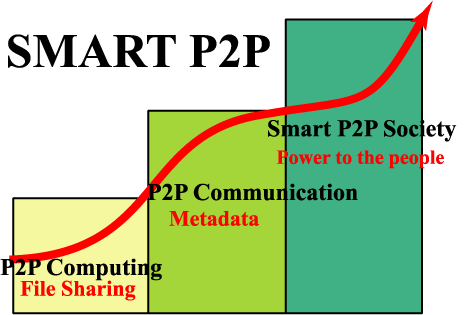 technology will be effected into the following
three stages:
technology will be effected into the following
three stages:
- The First Phase - P2P Computing:
This is autonomous distributed computing environment enabled to
exchange, share, and control directly between clients. The fixed
function as server and client becomes obsolete; CAS (Client as Server)
on the network changing and sharing necessary function among them
will be dominant. (Self-organization)
- The Second Phase - P2P Communication:
More active direct communications among clients (Net Buddy)
will be prevailing: ability to synchronous communication considering
receivers situation or context instead of present rude and sudden
intervention by telephone call, or asynchronous email, and to share
metadata (directory information and exchange of evaluation, etc.).
- The Third Phase - Smart P2P Society:
More optimized autonomous and distributed society where new social
units can mutually publish, exchange, and share of information using
P2P communication infrastructure. Autonomous consumers take major
initiatives in distributing resources for optimized production.
(Network of new distribution of social resources)
5.スマートP2Pソサイエティへ:
- P2P技術のもたらすインパクトは、以下の3
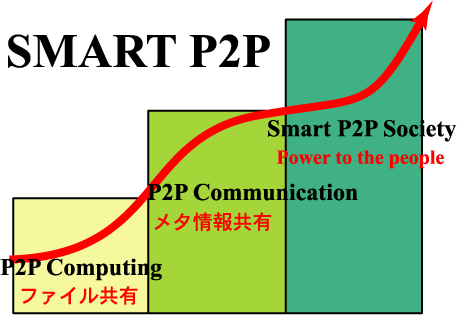 段階に分けて考えられる。
段階に分けて考えられる。
- 第1段階:P2P Computing:
クライアント相互間で、直接資源を交換・共有・制御を行う自律分散コンピューティングの環境。サーバとクライアントのような役割分担の固定化がなくなり、ネットワークに接続されたクライアント
(CAS=Client as Server) が違いに平等の立場(=Peer) で、お互いの役割を交代・分担する。 (自己組織化)
- 第2段階:P2P Communication:
ネットワーククライアントでもある仮想的な仲間(Net Buddy) 相互間でさらに積極的な直接情報が一般化する。電話のように相手時間への突発的侵入や、電子メールのような非同期性がなくなり、相手の状況に応じて同期的コニュニケーションを行い、またメタ情報
(検索情報や評価の交換) を共有し合うことが可能になる。
- 第3段階:Smart P2P Society:
自律分散的な新しい社会単位相互間で情報および資源の発信・交換・共有をおこなう自律型最適社会が到来する。自律的な消費者は、需要主導で商品・資源の配分に積極な役割を演じることになる。
(新たな資源配分のネットワーク)
>Top 6. Napster vs. Gnutella:
- Gnutella is famous and among the first of many decentralized technologies.
- History:
Gnutella was developed by Justin Franket and Top Pepper sometime
in March 2000.
(Etymologically, GNU is short for "GNU's Not Unix, and Nutella is the hazelnut and chocolate.)
- Features:
- Open source: The Gnutella was developed as open source
software.
- Virtual infrastructure:
Unlike standard Internet applications such as email, Web, and FTP,
Gnutella creates an application-level network in which the infrastructure
itself is constantly changing. Sure, the wires stay in the ground
and the routers don't move from place to place, but which wires
and which routers participate in the Gnutella network changes by
the second. The Gnutella network comprised a dynamic virtual
infrastructure built on a fixed physical infrastructure.
- >Top Servent:
Traditionally, there is clear difference and proper function of
"Server" which serve a file, while "Client"
which download the file. Gnutella blended these functions into one;
both Server and Client became "Servent." The slogan of
"The client is the server is the network." became to mean
software-based network independent on particular router, switch
and hub.
- Message-based:
Traditional application-level networks are cirucit-based, while
Gnutella is message-based. There is no idea of a persistent "connection,"
or circuit, between any two arbitrary hosts on the Gnutella network.
They are both on the network but not directly connected to each
other, and not even indirectly connected to each other in any predictable
or stable fashion. Messages are only relayed by bucket-brigade.
Each bucket is a message, and each brigade is a host.
- TCP broadcast:
The broadcast mechanism is interesting, because it works like the
real world. Suppose you are standing at a bus stop and you ask a
fellow when the next bus is to arrive. He may not know, but someone
nearby who has heard you will hopefully chime in with the desired
information.
- Auction are an example of message broadcasting. The auctioneer
asks for bids, and one person's bid is just as good as another's.
- Messages are assigned unique identifiers (128-bit UUID).
Every time a message is delivered, the UUID of the message is
memorized by the host it passes through. If the same message
is received again at a later time (it will have the same UUID),
it is not retransmitted.
- Another interesting idea is that each message has a TTL (Time-to-live) number. Typically, a query starts life with TTL
of 7. When it passes from host to host, the TTL is decremented.
When the TTL reaches 0, the request is not retransmitted again.
(Cf: This idea resemble to the function of 'Telomere', which
is said to limit the number of cell division.)
- >Top Dynamic routing:
Message broadcasting is useful for the query, but for the response,
it makes more sense to route rather than to broadcast. The UUIDs
that identify a message are memorized by the hosts it passes through.
When Host A responds to query, it looks in its memory and determines
which host set the query (Host B). It then responds with a reply
message containing the same UUID as the request message. Host B
receives the reply and looks in its memory to see which host sent
the original request (Host C ). And on down the line until we reach
Host X, which remembers that it actually originated the query. Remember,
a message is identified only by its UUID. It is not associated with
its originator's IP address, so without the UUID-based routes, there
is no way for a reply to be delivered to the node that made the
request. Without this dynamic routing, there would need to be some
kind of fixed Gnutella infrastructure.
6. Napster対Gnutella:
- Gnutellaは中央サーバ機能をもたないP2P技術の最初のものとして、有名である。
- 歴史:
Gnutellaは2000年3月頃に、Justin FranketおよびTom Pepperが開発した。 (Gnutellaの語源は、GNU is short for GNU's Not Unix. およびNutella is the hazelnut and
chocolateからきている。)
- 特徴:
- オープンソース (Open source): Gnutellaはopen source softwareとして開発された。
- 仮想インフラ (Virtual infrastructure):
標準のインターネットアプリケーション (email, Web, FTP)とは異なり、Gnutellaは常に変化するインフラとしてアプリケーションレベルのネットワークを作る。線路は固定しているし、ルータもあちこち動く訳ではないが、Gnutellaネットワークでの線路やルータは毎秒毎に変化している。いわばGnutellaネットワークは固定した物理的なネットワーク上に、ダイナミックで仮想的なインフラを構成している。
- サーベント ("Servent"):
従来は、fileをserveする"Server"と、fileをdownloadする「Client」の間には明確な区別と役割があった。Gnutellaは、これらを一つにブレンドした。ClientとServerは"Serven"となり区別なくなった。また、"The
client is the server is the network."のスローガンは、特定のrouter, switch,
hubに依存しないsoftware-based networkを意味するようになった。
- メッセージ・ベース (Message-based):
従来のアプリケーションレベルのネットワークは、回線ベースであったが、Gnutellaはメッセージベースである。Gnutellaには、任意のホスト間に持続的な"接続"、あるいは回線という概念はない。それは、同じネットワーク上にあるが、直接は接続しておらず、予知あるいは安定的という意味で間接的にも背悦族していない。メッセージがバケツリレー式
(bucket-brigade)に伝送されるだけである。それぞれのバケツがメッセージであり、それを運ぶのがホストである。
- TCPの放送 (TCP broadcast):
放送の原理は、実世界に似ていておもしろい。例えば、あなたがバスの停留所にいて、隣の人に次ぎのバスがいつ来るのか尋ねたとする。その人はそれを知らないかも知れないが、うまくすると近くでその会話を聞いた別の人が適切な回答をしてくれるかも知れない。
- オークションも同様にmessage broadcastingの例である。オークションには大勢競売に参加し、どの一人の入札も他の人の入札と等しく扱われるからである。
- 各メッセージには128Kbitのunique identifier (UUID)が付加される。各メッセージeが伝送される毎に、このUUID情報がホストに記憶される。もし同じメッセージが後に再度受領すると
(同じUUID情報を持つので) それは転送されない。
- もうひとつの興味深いアイディアは各メッセージがTTL(Time-to-Live)という寿命 (転送回数の限度)
を持つことである。典型的には、TTLは7で始まり、ホストを転送すると、このTTLの数字が減る。TTLが0となると、そのメッセージは再送されない。
- ダイナミック・ルーティング (Dynamic routing):
メッセージのbroadcastingは検索には向いているが、回答には不向きである。回答はbroadcastするのではなくroutingすべきである。メッセージを識別するUUID情報は、通過するホストに記憶される。ホストAが回答する際には、どのホストがその記憶を調べて、どのホストBが質問を投げたのかがわかる。回答するメッセージには質問メッセージとおなじUUID情報を入れて回答する。ホストBが回答を受け取り、その記憶をみると最初の質問を送ったホストCがわかる。このような仕組みでさかのぼり、その記憶によって実際にその質問を投げかけてホストXに至る。ここではメッセージがUUID情報によってのみ区別される点に留意すべきである。それは発信者のIPアドレスに関連していないので、もしUUIDベースのルートがなくなると質問を発したノードに回答を送る手段がなくなる。このダイナミックルーティングがなければ、Gnutellaは、ある種の固定的なインフラが必要になる。
- >Top
- Gnutella's Network:
Some users have 56Kbps modems, and others have, say, T3 lines. Over
time the T3-connected nodes migrate toward the center of the network
and carry the bulk of the traffic (High-speed nodes grow to a backbone
network) , while the 56Kbps nodes simultaneously move out toward
the fringes of the network, where they will not carry as much of
the traffic.
What results was overcrowding of the Gnutella traffic: To draw an
analogy, the Gnutella network became like a crowded room with lots
of conversations. Sure, you can still have a conversation, but maybe
only with one or two of your closest friends.
- Gnutellaのネットワーク:
あるユーザは、56K modemを使用し、他のユーザは例えばT3回線つ使用している。時間の経過に伴い、T3回線に接続しているノードはネットワークの中央に移動し、トラフィックの大半を伝送することになる。
(高速接続のノードが、バックボーンネットワークへと成長する。)
一方56Kbpsで接続したノードは同時にネットワークの周縁に移動し、トラフィックはそれほど伝送しなくなる。
Gnutellaのトラフィックが過剰になるといどうなるか。それは例えていえば、Gnutellaネットワークは沢山の会話の飛び交う混んだ部屋のようなものである。確かに会話することが可能だが、それはごく近くの一人二人との会話となる。
- >Top
- Gnutella's analogues:
Millions of users may be using Gnutella simultaneously, but they
will not all be visible to one another. That is the basic nature
of a public, purely P2P network. Of all the analogues that exits,
the most interesting two are cellular telephony and Ethernet.
- Cell site has a predetermined effective radius. Once
the caller is outside the operating radius, the site cannot
see the caller's telephone either. Each node is like a cell
site in the sense that it has a limited coverage radius, and
each node's coverage area overlaps with that of the nodes adjacent
to it. The key to making cellular phone systems scale is having
enough cells and enough infrastructure to connect the cells.
It is a similar story with Gnutella. There are numerous clusters
interconnected by high-speed lines. All this happened in an
unplanned and dynamic way.
- Ethernet is a broadcast network where each message
has a unique identifier. Hundreds of millions of computers have
ethernet, yet only a few dozen can share an Ethernet "segment"
before causing network gridlock. The solution for Ethernet was
to develop specialized hardware in the form of bridges, switches,
and routers. With that hardware, it became possible to squeeze
all those millions of computers onto the same network; the Internet.
- >Top Psedoanonymity:
On the Internet, identify is established using two points of data;
an IP address and the time. Most Gnutella messages do not contain
an IP address, so most messages are not useful in identifying Gnutella
users. The routing tables are dynamic and stored in the memory of
the countless Gnutella nodes for only a short time. It is therefore
nearly impossible to learn which host originated a packet and which
host is destined to receive it. Gnutella is spread throughout the
Internet, and the only way to monitor what is happening on the Gnutella
network is to monitor the entire Internet (=Confidentiality without
encryption).
But because of the breakdown in anonymity when a download is transacted,
Gnutella is not a s system for publishing information anonymously,
though It gives total anonymity in searching. Next generation technologies
may provide true anonymity through proxying and encryption to spell
the end of censorship.
- Gnutellaに似たもの:
何百万ものユーザはGnutellaを同時に利用するが、お互いにはその状況は見ることができない。それがパブリックなP2Pネットワークの特徴である。興味深いことに、これに似たような状況が、携帯電話とEthernet の場合に見られる。
- 携帯電話のcell siteには予め決められた有効半径がある。発信者がその半径外にいる場合は、その発信者の電話も認識できない。各cell
siteは、ノードに相当して、一定の半径以内だけ到達する。各ノードは隣接するノードと一部重複する。携帯電話システムの規模拡張は十分なcellとこれらのcellをつなぐ十分なインフラに依る。それはGnutellaの場合と同じである。高速回線で接続された多くのクラスターが必要となるが、これらはすべて予め予定されたのではなくダイナミックに成長していくのである。
- Ethernetは、各メッセージが固有の識別をもつ放送型のネットワークである。何億台というコンピュータがEthernetに接続されているが、その内の数十台がEthernetのセグメントを共有していて、ネットワークの渋滞を防いでいる。この機器によって、何百万台ものコンピュータを一つのインターネットというネットワークを成立させているのである。
- 疑似秘匿性 (Psedoanonymity):
インターネットでは、2カ所のデータはIPアドレスと時間の情報によって識別している。ほんとどのGnutellaのメッセージはIPアドレスを含まないので、Gnutellaユーザを特定するのには役立たない。ルーティングテーブルはダイナミックに変化し、膨大な数のGnutellaノードに短時間記憶されるだけである。従って、どのホストが質問のパケットを発信し、どのホスト宛に仕向られたのかを知ることはほとんど不可能である。Gnutellaはインターネット中に普及しており、Gnutellaネットワークで起きていることを監視しようとしたら、インターネット全体を監視することになってしまう
(暗号化なしの秘匿性) 。
但し、検索の場合、秘匿性は守られるが、ダウンロードする時にはこの秘匿性が崩れるので、Gnutellaは情報発信の秘密のシステムとはなり得ない。次世代の技術はProxyingや暗号化を通じて、検閲が成り立たないような秘匿性が提供されることになるかも知れない。
- >Top
- Gnutella revolution:
Before Gnutella, systems were centralized, and innovation in software
came mainly in the form of a novel business plan. The power of P2P
and its real innovation lies not just in its file-sharing applications
and how well it can fly in the face of copyright holders. The basic
premise is that individuals have something valuable to share, which
are computing power, network capacity, or information in files,
databased.
- Tomorrow's Internet will look quite different than it does
today. The WWW has only short time reality. P2P technology will
reshape the Internet dramatically. Today's P2P applications
are necessarily overtly P2P because they must provide application
and infrastructure simultaneously due to the lack of preexisting
P2P infrastructure. Tomorrow's applications will take this infrastructure
for granted and leverage it to proved more powerful software
and a better user experience.
- Gnutellaの革新性:
- P2Pの本当の革新は、ファイル交換システムにだけあるのではない。P2P技術の前提には、個々人には相互に共有すべき価値があるということである。その価値とは、コンピュータ力、ネットワーク力、fileやdatabaseの情報などである。P2Pアプリケーションは、これらの価値を交換する仕組みである。
- WWWはまだ6年間の現実でしかない!いわば、WWWはインターネットの世界の電報でしかない。これからのP2Pは、厳密な意味ではP2Pでも,
Client/Serverでもないだろう。現在のP2Pは、P2P infrastructureがないので、applicationとinfrastructureの両方を提供せざるを得ない。明日のアプリケーションは、このインフラを前提にして、もっと強力なソフトウェアが開発されていくことだろう。
- Decentralized P2Pは、検閲と著作権の終焉を意味するようになることだろう。P2Pは、有用で普遍的な必須のアプリケーションとなることは間違いない。
>Top 7. Gnutella cocktail party:
- 1) Gnutella concept closely
reflects those of the real world: Let's compare with the case of Coctail
party. (Source: "Peer-to-Peer, edited by Andy Oram, O'Reilly)
Cocktail
party
Gnutella
You enter at the
foyer and say hello to the closed person.
You connect to a
Gnutella host and issue a PING message.
Shortly, your friends
see you and come to say hello.
Your PING message
is broadcast to the Gnutella hosts in your immediate vicinity.
When they receive your PING, they respond with a PONG, essentially
saying, "Hello, pleased to meet you."
You would like to
find the tray of sushi, so you ask your nearby friends.
You would like to
find the recipe for strawberry pie, so you ask the Gnutella nodes
you've encountered.
None of your drunken
friends seen to know where the sushi is, but they ask the people
standing nearby. Those people in turn ask the people near them,
and so on, until the request makes its way around the room.
One of the Gnutella
nodes you're connected to has a recipe for strawberry pie and
lets you know. Just in case others have a better recipe, your
request is passed on to other hosts, which repeat the question
to all hosts known to them.
Eventually the entire network is canvassed.
A handful of partygoers a few
meters away have the tray. They pass back the knowledge of its
location by word of mouth.
You get several replies,
or "hits," routed back to you.
You walk over to
the keepers of the tray and partake of their sushi.
There are dozens
of recipes to choose from. You double-click on one and a request
is issued to download the recipe from the Gnutella node that has
it.
7. Gnutella風カクテル・パーティ:
- 1) Gnutellaによる通信は、現実世界と非常によく似ている。以下、カクテル・パーティとの比較をしてみよう。
(出典:O'Reilly社Andy Oram編"Peer-to-Peer")
カクテル・パーティ
Gnutella
パーティ会場入口に入って、近くの人に挨拶する。
まず、あるGnutellaホストに接続して
PING messageを発行する。
すぐに、あなたの友人があなたを見つけて挨拶する。
あなたのPING messageがすぐ近くのGnutellaホストに対してブロードキャストされる。彼等があなたのPINGを受信すると、彼等はPONGで応答する。それは要するに「こんにちわ、お会いできて光栄です。」という表現である。
あなたは寿司のお盆を探したいと思い、そのように近くの友達に尋ねる。
あなたは、ストロベリーパイのレシピを見つけたいと思い、そのようにあなたが出会ったGnutellaノードに尋ねる。
酔っぱらったあなたの友人は誰も寿司の場所を知らないらしいが、近くに立っている人達に聞いてくれた。その人達はさらに近くの人達へと次々聞いてくれて、ついにはその要求が部屋中ぐるりと巡回した。
あなたが接続したGnutellaノードの一つがストロベリーパイのレシピを持っていることをあなたに教えてくれた。たまたま他のノードももっと良いレシピをもっていたので、あなたの要求は他のノードにも伝えられた。ホスト達は知っているすべてのホストに対して同じ要求を繰り返す。
そうして結局すべてのネットワークがくまなく調べられた。
数メートル離れたパーティ参加者が寿司のお盆を持っていた。彼等は口頭でその場所のありかをそれぞれ口伝えで教えてくれた。
あなたにはいつかの返事
(即ちヒット) が要求のルートをたどって帰ってきた。
あなたはそのお盆をもっている人の所へ歩いて行き、寿司をいただくことができる。
結局、レシピは何ダースもあったが、その中から選んだ。あなたはダブルクリックをして、そのレシピのもっているGnutellaノードからダウンロードすることを要求した。
- >Top 2) In contrast, let's look at how things would be in a Napster cocktail party.
Cocktail party
Napster
You enter a the foyer and the
host of the party greets you. Around him are clustered 35 million
of his closer friends.
You connect to Napster and upload
a list of files that you are sharing. The file list is indexed
and stored in the memory of the party host: the central server.
Your only friend at this party
is the host.
The Napster server say, "File
list successfully received."
You would like to find the tray
of sushi, so you find your way back to the foyer and ask the host
where exactly the tray has gone.
You would like to fine the recipe
for strawberry pie. So you type "strawberry" into the
search box, and the request is delivered to the central server.
The host says, "Oh, yes.
It's over there."
You get several replies, or "hits,"
from the Napster server that match your request.
You hold the tray and choose your
favorite sushi.
You decide which file you want
to download and double-click. A request is issued to the Napster
server for the file.
The Napster server determines which file you desire and whose
computer it is on, and brokers a download for you. Soon the download
begins.
- 2) Napsterの場合、対照的に、クライアント/サーバ式のカクテルパーティとなる。
カクテル・パーティ
Napster
あなたは、パーティ会場入口を入る。そのパーティのホストがあなたに挨拶をする。ホストの周囲には、35百万もの親しい友人が取り巻いている。
あなたは、Napsterに接続して、共有したいファイルリストをアップロードする。そのファイルリストには索引があり、パーティのホストである中央サーバに記憶される。
あなたのこのパーティでの唯一の友人はホストだけである。
Napsterサーバが「ファイルリストは確かに承りました」と言う。
あなたは寿司のお盆を見つけたいと思い、入口に戻ってホストにその盆がどこにあるか正確が場所を尋ねる。
あなたはストロベリーパイのレシピを見つけたいと思う。そうしてあなたは「ストロベリー」とタイプして検索の箱に入れる。その要求は中央サーバに伝えられる。
ホストは「ああ、それならあそこにあります。」と答える。
あなたは、要求に合致するいくつかの返事、即ちヒット、をNapsterサーバからもらう。
あたなはそのお盆を得て、好きな寿司をいただく。
あなたはどのファイルをダウンロードしたいかを決めてダブルクリックする。そのファイルの要求はNapsterサーバに発行される。Napsterサーバはあなたがどのファイルを要求しているか、またどのコンピュータが接続しているかを決めて、あなたがダウンロードするよう仲介する。まもなくダウンロードが始まる。
>Top 8. How Gnutella works:
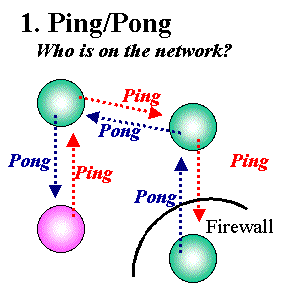
8. Gnutellaの仕組み:
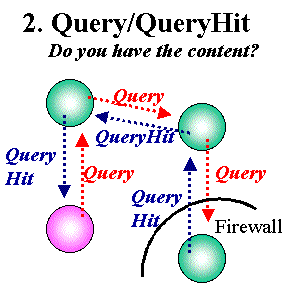
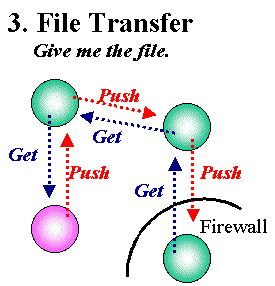
- >Top
- <Step-1> Ping/Pong:
Determining who is on the network:
A Ping packet announces your presence on the network. When
another computer (=node) hears your Ping, it will respond with a Pong packet. It will also forward your Ping packet to other
connected to which it is connected and they too will send back Pong
packets. (See Figure-1). Each Ping and Pong packet contains a Globally
Unique Identifier (GUID). A Pong packet also contains an IP address,
port number, and information about how much data is being shared
by the node that sent the Pong. Once the Pong packets have told
you which nodes are your active peers, you can start making searches.
- <Step-2> Query/QueryHit:
Searching:
Query packets let you search the data on other nodes by asking
whether there are sharing specific content, asking "Do you
have any content that matches the string "xxxx?" Each
of the nodes does two things.
- First, each checks to see if it has any content that matches
the search string. In this case it looks to see if there is
a file in a specified directory marked "sharable to the
outside world."
- Second, each node sends your Query packet on to all the nodes
to which it is connected. These nodes in turn check their directories
and send your Query packet to their web of nodes (Figure-2).
This process continues until the Query packet gets too old and
times out. (predefined Time-To-Live, 'TTL').
- >Top <Step-3> File Transfer:
Ready to download:
Let's say that three nodes that received your Query packet have
matches. Each of the three nodes will send you a QueryHit packet via the same delivery route that the Query packet originally
traveled. The QueryHit packet contains the IP address and GUID of
the node that has the data as well as information about the file
that matched you query.
When you receive a QueryHit packet you have the option to download.
File transfers use the HTTP protocol's GET method directly between
you and the node that has the file you want (Figure-3)
Occasionally, due to a firewall, you will be unable to initiate
a connection directly, then the Push packet come into play. The
Push packet delivers a message to the node with the file you want
via the route the QueryHit packet originally traveled, except in
reverse. The Push packet tells this node that you'd like to download
a file but can't initiate an HTTP connection. This node node then
becomes the initiator, and attempts to connect directly to you.
- <Step-1> Ping/Pongの応答:
ネットワーク上の相手を決める。
まずPing packetで、ネットワーク上のあなたの存在を知らせる。他のコンピュータ (=ノード) があなたのPingを受け取ったノードはPong packetで反応し、同時に、他の接続しているノードにあなたのPing packetを転送する。転送されたノードもまたPong
packetで応答してくる。 (図1参照) いずれのPing/Pong packetには, GUID情報 (Globally Unique
Identifier)が含まれている。またPong packetには、IP address, Port number, Share可能なdataに関する情報が含まれている。一旦、Pong
packetを受け取ると、あなたはどのノードがactive peerであるかがわかるので、検索を開始できる。
- <Step-2> Query/QueryHitの応答:
ファイル検索開始:
他のノードに対し、特定ファイルがあるかどうかを聞くために、検索のQuery packetを送る。このパケットには、xxxxの文字列に合致するファイルかがあるかどうか聞くのである。これに対するノードの反応は以下となる。
- まず、各ノードは、その文字列に合致するファイルがあるかどうか自分のdirectoryを調べる。もしあればそのファイルが「外部との共有可能」と記された特定のdirectoryに入っているか調べる。
- 次に、各ノードは、あなたのQuery packetを接続しているすべてのノードに転送する。これらのノードはそれぞれのdirectoryを調べ、さらにQuery
packetを他の接続しているノードに転送する。このプロセスを限度回数 (Time To Live, TTLで予め設定)
繰り返す。
- <Step-3> ファイル転送:
ダウンロードの開始:
QueryHit packetを受け取ったノードで当該ファイルを持っているノードが3つあったとする。各々のノードはあなたにQueryHit
packetをどれを受け取ったのと同じルートを逆にたどって応答する。QueryHit packetには、IPアドレス、ノードのGUID、合致したファイルに関する情報が含まれる。そしてQueryHIt
packetを受信することで、ダウンロードするオプションを得る。ファイル転送はHTTPプロトコルのGETコマンドは直接ダウンロードする。
時々、ファイアウォールのために、直接接続できない場合には、Push packetの出番となる。Push packetは、QueryHIt
packetがたどったルートを遡って、当該ファイルを持っているノードに対してメッセージを送る。Push packetは、あなたが当該ファイルをダウンロードしたいがHTTP接続をすることができないことが書いてある。このノードは、initiatorとなり、あなたと直接接続を試みる。
- HTTPのGETコマンドによって、目的のファイルをダウンロードする。通常は、そのファイルを有するコンピュータとHTTP接続を始めるが、Firewallのために直接接続できない場合は、PUSH
REQUEST packetによって、QueryHit packetを受け取ったルートを逆に辿ってファイルをダウンロードする。
- >Top
- Remarks:
- Function of Central server:
Central-index systems are always more efficient than true P2P systems
because they rely on centralized catalogs and don't require each
peer to participate in message routing.
One solution is a hybrid P2P network where high-bandwidth servents
form a virtual backbone and low-bandwidth computers connect in a
more traditional client/server manner.
However, centralized systems don't have the fail-safe architectural
advantage and don't scale proportionately to the number of users
on the system. In other words, central-index networks face a problem
similar to that of large Web sites. A certain number of servers
are required to serve a certain number of users, often resulting
in unwieldy cluster of servers, or cluster of clusters in very large
installations.
- Metadata:
The current Gnutella network has no index and no metadata schema,
relying instead on filenames alone. Future P2P technology acting
in concert with an advanced metadata schema (like RDF) should
greatly increase the utility of true P2P.
- >Top For Business Use:
- It will be necessary to adopt a greatly improved protocol.
The addition of security, encryption, digital certificates,
authentication, reporting, and quality of service (QoS) would
make P2P even more compelling for legitimate business and consumer
use.
- The decentralized nature of P2P reduces management costs and
empowers individuals to adminster content within their own area
of specialization or interest.
- Open Development:
- They are several independent groups who are working to make
P2P much more powerful, useful, and secure. Such groups are
security group, client group, a backbone group, a developer
group, an advanced search group, etc.
A group known as General Purpose Location Protocol (gPulp) is
working on what might become the next version of the Gnutellla
protocol.
- 中央サーバの役割:
中央にIndexを持つシステムの存在は、集中されたカタログ情報を利用でき、個別のpeerに問い合わせ情報を配送してもらう必要がないので、真のP2P
systemよりもずっと効率がいい。
広帯域のserventが仮想的なバックボーンを構成し、狭帯域のコンピュータや従来のようなclinet/server環境で接続するというのも一案である。
しかし、中央のサーバシステムは、fail-safeな構造をもっておらず、また、ユーザ数に比例して規模拡大できない。換言すれば、中央サーバの存在は結局巨大なWebサイトと同様の問題を抱えることになる。ある数のユーザ数をサポートするには一定数のサーバが必要となり、しばしばやっかいなサーバ群、さらには、サーバ群のサーバ群というような巨大設備とならざるを得ない。
- Metadata:
現在のGnutella networkは、filenameだけに依存しており、それ以外のindexやmetadata schemeを持たない。将来のP2P技術は、もっと進んだ
(RDFのような) metadataを持つようになることが、真のP2Pの効用を増大させるに違いない。
- ビジネス利用:
- 今後はプロトコルを一層改善する必要がある。Securityの追加、暗号化、デジタル署名、認証、レポーティング機能、QoSなどの機能追加が、ビジネスやコンシューマ用に利用されるためには必須となる。
また、filename以上のcontentsに関わるmetadataによる検索。
- また、中央サーバがないことによる管理費用の削減、および個々のユーザにとっては、それぞれの専門や興味分野の中でのコンテンツ管理が可能となる。
- オープンな開発手法:
- P2Pをもっと強力、有用、安全なものに作り替えようとするいくつかの独立グループがある。これらには、セキュリティグループ、クライアントグループ、バックボーングループ、開発者グループ、先進研究者グループなどがある。
なお、General Purpose Location Protocol ("gPulp")のグループは、次世代のGnutellaプロトコルについて検討している。
>Top 9. Leaders of P2P:
- P2P accelerates
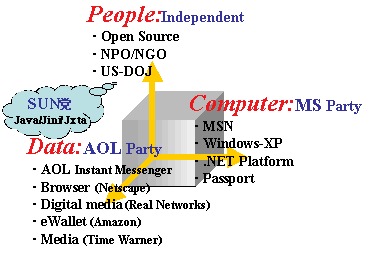 social reform in 21st century, not only reforms
architecture of the Internet but also changes social structure through
the empowerment of people as active participants in the network.
P2P blurrs the function of server and client, and enpowers people
as clients of the social pyramid.
social reform in 21st century, not only reforms
architecture of the Internet but also changes social structure through
the empowerment of people as active participants in the network.
P2P blurrs the function of server and client, and enpowers people
as clients of the social pyramid.
- If we compare the relationship of Mainframe/Dumb Terminal system
to absolute monarchy, Server/Client system to representative democracy,
and P2P to direct democracy. In 20th century nation-states have
been the major players without doubt, but now they are becoming
local authority according to globalization and empowerment of the
people.
- In 21st century, the functions of nation, market and community
including people will share to play each unique role with having
some tensions and vicissitudes among them.
- In P2P global competition, typical leaders are appearing in each
three camps as per the left chart:
- Computer-field leader:
Microsoft is the acknowledged leader of computer field with
its oligopolistic market share of desktop OS (Windows) packaged
with browser (Internet Explorer) and business application (MS Office).
Also Microsoft recognized the importance of P2P technology, trying
to develop various defacto-to-be software.
- Data-field leader:
AOL established its superior position in the field of
producing contents by integration of the capacity of Netscape, Real
Networks, Time Warner, then adding alliance with Amazon.com.
- People-field leaders:
These are independents composed of several factions;
one is a movement of NPO and NGO against control by US government
in the name of globalization, another is of open source development
of software against Microsoft's oligopoly, supported by Sun Microsystems
as the developer of Java and Jxta, and the other is of antitrust
policy guided by US Department of Justice.
9. Leaders of P2P:
- P2Pは、21世紀のインター
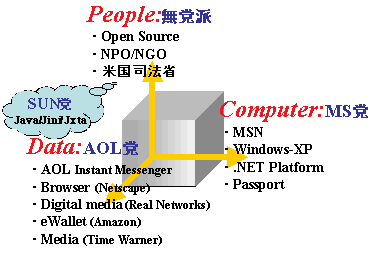 ネットの構造変化のみならず、人々のネットワークへの積極的な参加というエンパワーメントを通じて社会構造に変化をもたらす。
それは、P2PがServerとClientとの区別をあいまいにするだけでなく、人々を社会ピラミッドのクライアントとしてエンパワーさせるからである。
ネットの構造変化のみならず、人々のネットワークへの積極的な参加というエンパワーメントを通じて社会構造に変化をもたらす。
それは、P2PがServerとClientとの区別をあいまいにするだけでなく、人々を社会ピラミッドのクライアントとしてエンパワーさせるからである。
- Mainframe/Dumb Terminalを絶対王政に対応するとすれば、Server/Clientを代議制民主主義になぞらえると、P2Pは直接民主主義になる。まさに20世紀の主役であった国家権力が、グローバル化と人々のエンパワーの進展によって、ローカルな権威になりつつある。但し、21世紀においては、国家の役割、市場の役割、コミュニティや人々の役割、即ち、公・私・共の役割は緊張関係の中にも共存していく。
- さてP2Pを巡る開発競争の中で、それぞれの軸にまさに軸足をおくリーダ達の存在が際立ってきている。それを戯画的に描くと左図のようになる。
- Computer分野のリーダは、デスクトップOS (Windows)
とブラウザ (IE) とビジネスアプリケーション (Office)の分野での独占的シェアを持つMicrosoftが、この分野のリーダと言わざるを得ない。すでにP2P分野の重要性を認識し、特に「技術面」でのMS流の標準化を意図した開発を精力的に行っている。
- Data分野のリーダは、AOLが、Netscape,
Real Networks, Time Warnerに加え、さらにはAmazonと提携することで、コンテンツ開発を中心とする「市場面」でのリーダとなっている。
- People分野のリーダは、いわば無党派であって、米国流の上からのグローバル支配に対するアンチテーゼとしての下からのNPO/NGOの動き、あるいはHierarchicalなClosedな開発手法に対するOpen
Sourceの開発手法の動きなどがある。また、Microsoftと対抗する米国司法省も結果としては、無党派のグループの一員的な役割を演じている。これに、Microsoftに対抗するSun
MicrosystemsからのJavaやJxtaなどでの応援も加わっている。
Comment
- The covering of O'Reilly P2P book is a P2P imaged picture painted
by Michelangelo.
- We cannot take our eyes off this P2P architecture.
- O'ReillyのP2Pの本の表紙にはミケランジョロの描いたP2Pのイメージの絵になっている。
- このP2Pアーキテクチャには目が離せない。
 |
Peer-to-Peer Summary
|
Cat: ICTPub: 2001#: 0107a |
|
Andy Oram |
01331u/17z25r |
Title |
Peer-to-Peer Summary |
ピア・ツー・ピア サマリー |
|---|---|---|
Compiler |
Andy Oram | Andy Oram |
Published |
2001 |
2001 |
Index |
||
Why? |
|
|
Summary |
要約 |
|||||||||||||||||||||||||||||
>Top 0. Prologue:
|
0. プロローグ:
|
|||||||||||||||||||||||||||||
>Top 1. Advent of P2P:
|
1. P2Pの登場:
|
|||||||||||||||||||||||||||||
|
|
|||||||||||||||||||||||||||||
>Top 2. Definition of P2P:
|
2. P2Pの定義:
|
|||||||||||||||||||||||||||||
>Top 3. Evolution of P2P:
|
3. P2Pの進化:
|
|||||||||||||||||||||||||||||
>Top 4. Meme Map of P2P:
The left chart shows P2P Meme Map, where "meme" means a kind of gene of thought. Three axes are the directions of evolution: "People", "Data", and "Computer".
|
4. P2Pの遺伝子マップ:
|
|||||||||||||||||||||||||||||
|
|
|||||||||||||||||||||||||||||
|
|
|||||||||||||||||||||||||||||
|
|
|||||||||||||||||||||||||||||
|
|
|||||||||||||||||||||||||||||
Remarks:
|
|
|||||||||||||||||||||||||||||
>Top 5. Toward Smart P2P Society:
|
5.スマートP2Pソサイエティへ:
|
|||||||||||||||||||||||||||||
>Top 6. Napster vs. Gnutella:
|
6. Napster対Gnutella:
|
|||||||||||||||||||||||||||||
|
|
|||||||||||||||||||||||||||||
|
|
|||||||||||||||||||||||||||||
|
|
|||||||||||||||||||||||||||||
>Top 7. Gnutella cocktail party:
|
7. Gnutella風カクテル・パーティ:
|
|||||||||||||||||||||||||||||
|
|
|||||||||||||||||||||||||||||
>Top 8. How Gnutella works:
|
8. Gnutellaの仕組み:
|
|
||||||||||||||||||||||||||||
|
|
|||||||||||||||||||||||||||||
|
|
|||||||||||||||||||||||||||||
>Top 9. Leaders of P2P:
|
9. Leaders of P2P:
|
|||||||||||||||||||||||||||||
Comment |
|
|